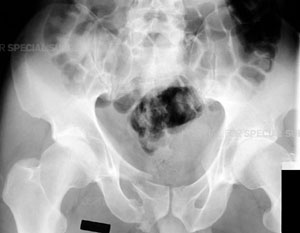

To understand and appropriately utilize the Young-Burgess classification system of pelvic ring injuries, clinicians must have a basic understanding of the pelvic ligamentous anatomy. By correctly identifying the pelvic ring injury, trauma surgeons and emergency physicians can provide adequate initial treatment, as well as convey important information about the anatomy of the injured structures to the orthopedic surgeon managing this patient. The Young-Burgess classification system is the most commonly utilized classification system in the evaluation of pelvic ring injuries and is expanded upon in detail below. Similarly, fractures of the acetabulum are a frequent occurrence, particularly in the setting of high energy traumas, hip dislocations, and falls in the elderly, and are studied in detail classified by the anatomy of the fracture. Certain types of pelvic fractures do not disrupt the pelvic ring, such as iliac wing fractures, which can typically be managed without operative intervention. Therefore, fractures of the pelvis occur most commonly in the setting of a high-impact trauma and are often associated with additional fractures or injuries elsewhere in the body. Find out more about this in the osteosynthesis section.Due to the inherent structural and mechanical integrity of the pelvic ring, the pelvis is a highly stable structure. This is usually achieved using an external fixation device. Then during the operation, the source of the bleeding will be stopped and the pelvis will be surgically stabilised. If there is heavy bleeding, the person’s circulatory system will need to be stabilised before the operation can take place. Unstable pelvic fractures must be surgically treated. The conservative treatment consists of bed rest, pain relieving medication and physiotherapy exercises Stable pelvic fractures generally do not require surgery.
#BONE FRACTURE PELVIC MANUAL#
These include a careful manual examination of the pelvis, radiological imaging and the identification of any sources of bleeding. Various different examinations are used to diagnose a pelvic fracture. If a person exhibits these symptoms, it is a medical emergency and they must undergo immediate surgery. Blood-stained urine, an extremely rapid pulse and a pale face can indicate damaged blood vessels or internal organs. If the bony pelvis is broken, it will be impossible to walk. Typical symptoms include pain and swelling around the pelvis, as well as limited mobility of one leg. Unstable pelvic fractures are dangerous, because the instability of the pelvis can lead to blood vessel damage and life-threatening internal bleeding.Ī stable pelvic fracture usually causes fewer symptoms than an unstable fracture. If the bony pelvis is damaged this is called an unstable pelvic fracture, because the pelvis becomes unstable or loose. With stable fractures, the bony pelvis is not damaged, so the pelvis remains stable. Depending on which pelvic bones are affected, the diagnosis will either be a stable or unstable pelvic fracture. Younger people only suffer pelvic fractures if they are subject to extreme trauma, such as falling from a great height or being involved in a road traffic accident.

A relatively simple fall can cause a pelvic fracture in older people – particularly older women – who have osteoporosis. The pelvis consists of several bones that form a ring and connect the spine with the legs. High cholesterol, high blood lipid levels.


 0 kommentar(er)
0 kommentar(er)
